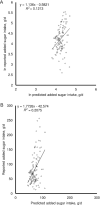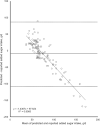Objective Biomarkers for Total Added Sugar Intake - Are We on a Wild Goose Chase?
- PMID: 32805008
- PMCID: PMC7666891
- DOI: 10.1093/advances/nmaa093
Objective Biomarkers for Total Added Sugar Intake - Are We on a Wild Goose Chase?
Abstract
Misreporting of added sugar intake has been the major criticism of studies linking high added sugar consumption to adverse health outcomes. Despite the advancement in dietary assessment methodologies, the bias introduced by self-reporting can never be completely eliminated. The search for an objective biomarker for total added sugar intake has therefore been a topic of interest. In this article, the reasons this search may be a wild goose chase will be outlined and discussed. The limitations and inability of the 2 candidate biomarkers, namely urinary sucrose and fructose and δ¹³C isotope, which are based on the 2 only possible ways (i.e., difference in metabolism and plant sources) to identify added sugar based on current knowledge in human physiology and food and nutritional sciences, are discussed in detail. Validation studies have shown that these 2 candidate biomarkers are unlikely to be suitable for use as a predictive or calibration biomarker for total added sugar intake. Unless advancement in our understanding in human physiology and food and nutritional sciences leads to new potential ways to distinguish between naturally occurring and added sugars, it is extremely unlikely that any accurate objective added sugar biomarker could be found. It may be time to stop the futile effort in searching for such a biomarker, and resources may be better spent on further improving and innovating dietary assessment methods to minimize the bias introduced by self-reporting.
Keywords: added sugars; biomarker; metabolite; urinary sucrose; validity; δ¹³C isotope.
Copyright © The Author(s) on behalf of the American Society for Nutrition 2020.
Figures



Similar articles
-
Comparing Self-Reported Sugar Intake With the Sucrose and Fructose Biomarker From Overnight Urine Samples in Relation to Cardiometabolic Risk Factors.Front Nutr. 2020 May 6;7:62. doi: 10.3389/fnut.2020.00062. eCollection 2020. Front Nutr. 2020. PMID: 32435652 Free PMC article.
-
Breath 13CO2-evidence for a noninvasive biomarker to measure added refined sugar uptake.J Appl Physiol (1985). 2021 Apr 1;130(4):1025-1032. doi: 10.1152/japplphysiol.00648.2020. Epub 2021 Jan 14. J Appl Physiol (1985). 2021. PMID: 33444124
-
Sugars measured enzymatically in a fasting overnight urine sample are not sensitive biomarkers of dietary added sugar intake in postmenopausal women.Nutr Health. 2022 Jun 9:2601060221106819. doi: 10.1177/02601060221106819. Online ahead of print. Nutr Health. 2022. PMID: 35679080
-
Intake of added sugar in Malaysia: a review.Asia Pac J Clin Nutr. 2016;25(2):227-40. doi: 10.6133/apjcn.2016.25.2.13. Asia Pac J Clin Nutr. 2016. PMID: 27222405 Review.
-
Current WHO recommendation to reduce free sugar intake from all sources to below 10% of daily energy intake for supporting overall health is not well supported by available evidence.Am J Clin Nutr. 2022 Jul 6;116(1):15-39. doi: 10.1093/ajcn/nqac084. Am J Clin Nutr. 2022. PMID: 35380611 Free PMC article. Review.
Cited by
-
Twenty-Four-Hour Urinary Sugars Biomarker in a Vending Machine Intake Paradigm in a Diverse Population.Nutrients. 2024 Feb 23;16(5):610. doi: 10.3390/nu16050610. Nutrients. 2024. PMID: 38474737 Free PMC article.
-
Added Sugar, Sugar-Sweetened Beverages, and Artificially Sweetened Beverages and Risk of Cardiovascular Disease: Findings from the Women's Health Initiative and a Network Meta-Analysis of Prospective Studies.Nutrients. 2022 Oct 11;14(20):4226. doi: 10.3390/nu14204226. Nutrients. 2022. PMID: 36296910 Free PMC article.
-
A Systematic Review of Metabolomic Biomarkers for the Intake of Sugar-Sweetened and Low-Calorie Sweetened Beverages.Metabolites. 2021 Aug 19;11(8):546. doi: 10.3390/metabo11080546. Metabolites. 2021. PMID: 34436487 Free PMC article. Review.
-
Total and Free Sugar Levels and Main Types of Sugars Used in 18,784 Local and Imported Pre-Packaged Foods and Beverages Sold in Hong Kong.Nutrients. 2021 Sep 27;13(10):3404. doi: 10.3390/nu13103404. Nutrients. 2021. PMID: 34684405 Free PMC article.
-
The time has come to reconsider the quantitative sugar guidelines and related policies.NPJ Sci Food. 2024 Nov 1;8(1):88. doi: 10.1038/s41538-024-00332-4. NPJ Sci Food. 2024. PMID: 39487154 Free PMC article.
References
-
- World Health Organization Guideline: Sugar Intake For Adults and Children. Geneva; 2015. - PubMed
-
- Cottrell RC. Sugar: an excess of anything can harm. Nature. 2012;483(7388):158. - PubMed
-
- Johnson RK, Appel LJ, Brands M, Howard BV, Lefevre M, Lustig RH, Sacks F, Steffen LM, Wylie-Rosett J, American Heart Association Nutrition Committee of the Council on Nutrition PA et al. Dietary sugars intake and cardiovascular health: a scientific statement from the American Heart Association. Circulation. 2009;120(11):1011–20. - PubMed
-
- Watts G. Sugar and the heart: old ideas revisited. BMJ. 2013;346:e7800. - PubMed

